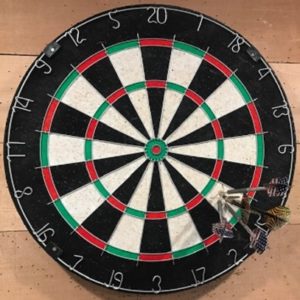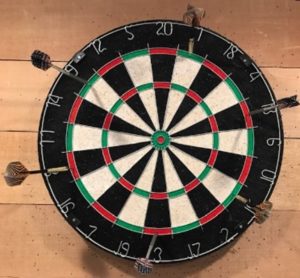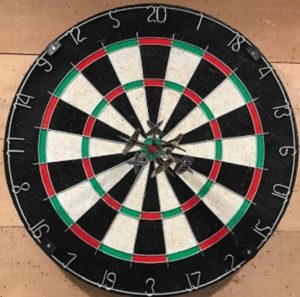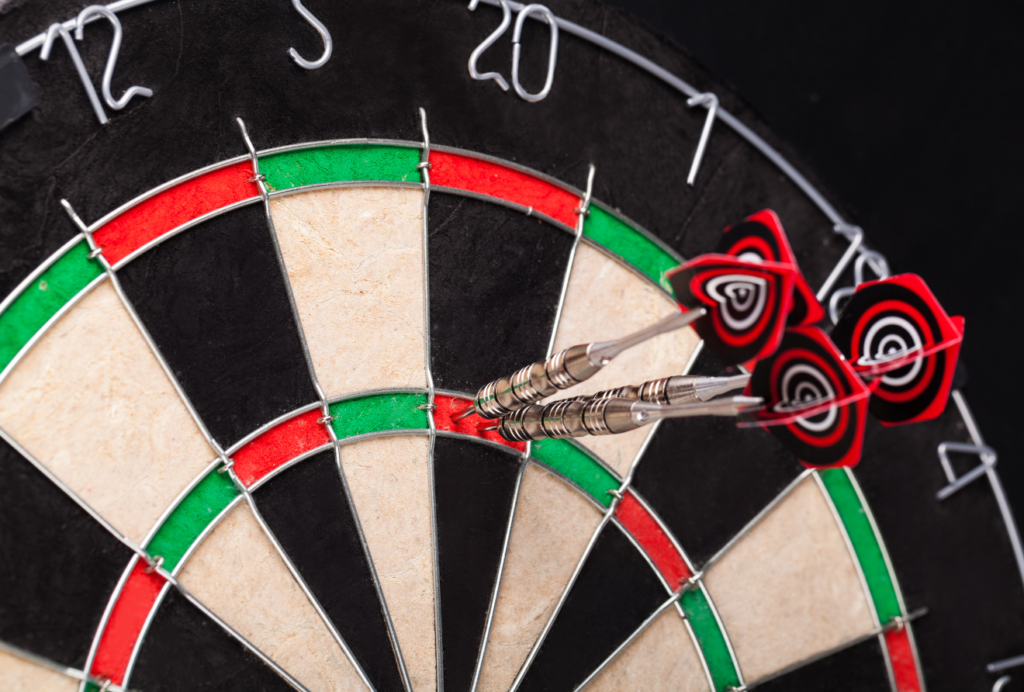September 20, 2022 Doug Koehler
Precision or Accuracy: Which is More Important?

When it comes to the quality of your product, is it better to be precise or accurate? To be able to answer that question, we need to understand the differences between the terms. Accuracy is how close you are able to come to achieving your targeted value. Precision is how well you are able to achieve the same value repeatedly and consistently.
High degrees of precision can be achieved while still incurring poor accuracy when the variation of a process has been reduced, but corrections have not yet been made to consistently achieve the target value. As shown in Image 1, the darts are very precisely located, but they are not accurately placed in the bullseye. Does it do you any good to have a high degree of precision if you have poor accuracy? Yes; in most cases, high precision shows that you have reduced the variation in your process.

Degrees of accuracy and precision are relative to the values being measured. The dartboard shown in Image 2 doesn’t appear to have the darts accurately thrown at it. But if you envision this to be a paper target for someone shooting at a distance of 1,000 yards, all the “shots” would be within the “10” ring, which is relatively accurate shooting for that distance. In a manufacturing environment, degrees of accuracy and precision also come into consideration. The level of precision and accuracy all depend on the process and product’s requirements.
A Place to Start
Like a target shooter, the first thing you need to do is make sure you are able to “get on the paper,” being able to see where you are in relation to where you want to be. In manufacturing, getting on the paper is like making a product that is meeting the minimum requirements but may not be exactly what is desired. If you are shooting a bow and arrow or a rifle for the first time, the sights might be so far off that when you aim at the bullseye, you actually miss the target. This can also be the case in manufacturing if you do not have the ability to measure an important parameter or have yet to even look at what to measure. You need to start by finding the parameters that are critical to the quality (CTQ) of your product. Work with your customer to determine what truly impacts the functionality and useability of the product.

Zeroing In
Inexperienced shooters often have numerous variables in their process that can influence their ability to shoot with a high level of precision. Some may blame the rifle they are using, and although a cheap rifle can contribute to a shooter’s lack of precision, the majority of variability is usually the shooter’s skill set. Things like jerking the trigger instead of pulling smoothly, holding the gun too tight or too loosely or forgetting to control your breathing can have dramatic effects on your accuracy. Variation in a manufacturing process can also come from a multitude of areas. The most common, and the first that should be analyzed, are people, materials, environment, equipment and methods. As discussed in a previous blog, performing a root-cause analysis (RCA) can help you determine issues in your process, resulting in greater likelihood of hitting your target consistently, like in Image 3.
Finding Your Drift
A target shooter knows that the one constant to shooting is change. It could be the direction or speed of the wind. It could be the temperature or humidity. Even the temperature of your barrel can change your precision. Just like target shooting, there are numerous factors that can send your manufacturing drifting off target. Seemingly simple things like a new batch of material from your supplier may cause changes in the quality of your product if batch-to-batch variations exist and aren’t adjusted for in your processes.
Precision or Accuracy?
So which is more important, precision or accuracy? As I’ve noted, the two are closely related and intertwined. If you do not have an acceptable level of precision, it’s difficult to consistently achieve your target value. And if you do not have an acceptable level of accuracy, a high level of precision may be worthless when you can’t hit the target.
What level of accuracy and precision do you need in your manufacturing processes? Only you and your customers can determine that. At Excellerate, we work with our customers to find new and improved ways to measure our accuracy and precision, to continuously improve on each.
Interested in learning more? Check out our other articles and subscribe to be the first to know about future Excellerate blog articles.

 Precision or Accuracy: Which is More Important?
Precision or Accuracy: Which is More Important?

